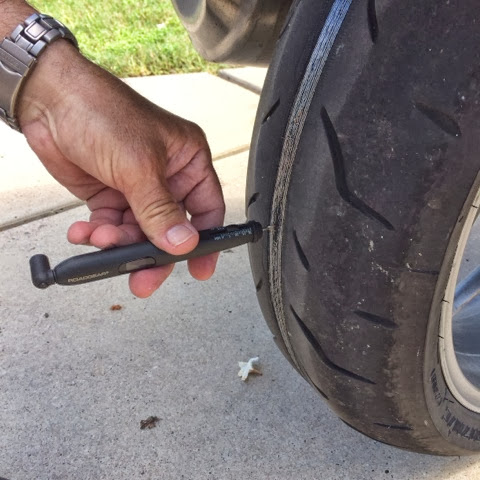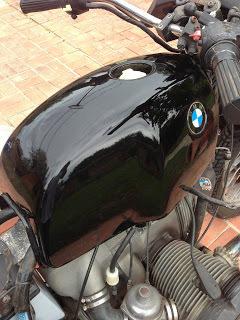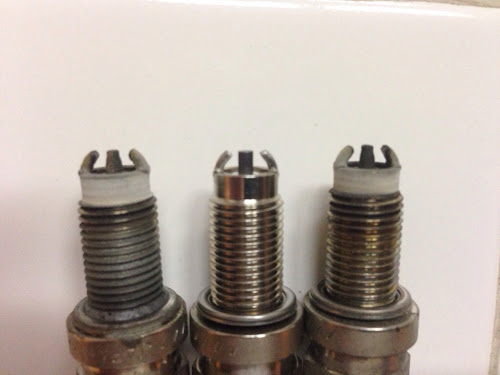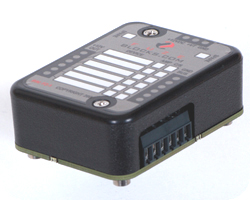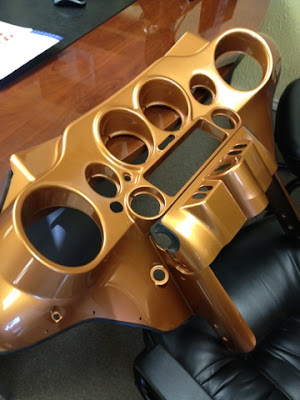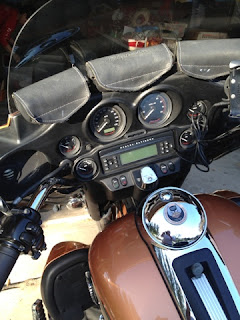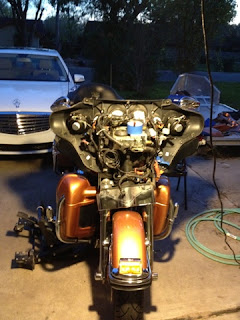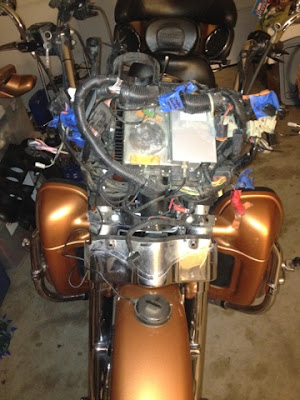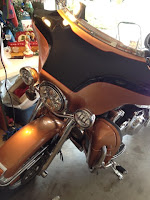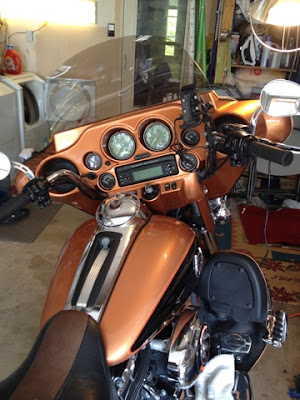|
| Highway & Lupe from Corpus Christi, Texas |
We haven't travelled into Mexico on motorcycles since 2008 due to the rash of violence especially along our border towns, but for those that venture into Mexico here's a report on the basics for travel in Mexico. It may be dated and things always change so make sure to find out what's new and what may be different.
You'll need permits for yourself and
your ride if you plan to go beyond the 22 kilometer mark. A kilometer is .62 of
one mile so just multiple 20 X 6 = 120 or 12 miles. This formula will come in
handy throughout your trip. It's best to get your permits at least a day or two
before your ride if time permits, if pressed for time you can get them as you enter Mexico
at the Port of Entry. Getting
those requires pesos. The best place to get your dollars converted to pesos is
at any of numerous “Casa de Cambio” (Exchange House) businesses located at all
US border towns. Some banks also
exchange dollars for pesos and usually at a better rate since they provide it
as a service to their customers. In 2008 the exchange rate was approximately 10
pesos to one dollar. I usually carry about $100 US dollars per day or a
thousand pesos.
Here are my typical day’s expenses
(in US Dollars):
Gas: $25
Tolls: 25
Snacks: 20
Meals: 25
Hotel: 75
Beer: 25
Souvenirs:
5
Total: $200.
That’s about $2,000 pesos in one
day or well beyond my $1,000 budget. So I usually cut back on one or more of
the above. A good hotel can be $90 or more per day and a small non-name brand
hotel in a small town is usually $30 to $40 per day. I don’t buy many souvenirs
and I usually don’t eat three full meals a day, but do enjoy a great dinner
with refreshments before. If the bigger cities are your destination then you
can limit the amount of cash you carry if you charge your room on a credit
card. Always carry small bills in a pouch or a pocket you can reach into with
your gloves on to pay for tolls. Tolls usually run between 19 to 30 pesos and
you don’t want to have to turn your bike off and start striping clothes off
just to reach for a toll. So have it ready and within reach. If you don’t have
small bills you’ll be getting lots of change and that will pose a problem if
you don’t have a ready place to stash it without having to stop.
You need two permits. The Tourista
Permit which is your personal traveling permit and one for your bike, unless your significant other is riding along with you then they'll need a permit as well.
To get these permits you need to
cross into Mexico with the bike. It’s best to do it on a weekday afternoon when it’s not so
crowded. You’ll have to pay anywhere from one to two US dollars to cross from
the US side to Mexico. Have your toll ready. Friday afternoons are too busy
and you risk running into long lines and the weekends are not good. I usually
cross over at Nuevo Progresso which is a less crowded international crossing
and it gets me in and out usually within 30 minutes. As you cross on your bike
the Permit Offices are typically just before the Mexican Customs, where all the
traffic is usually going – into Mexico. There are signs in Spanish and English
instructing you where to go to get your permits. In some international
crossings if you go beyond the inspection point on the Mexican side where the custom officers are
located you may have to turn around, pay a toll at the Mexican side and make
another turn back towards Mexico to get to the Permit Office. Trust me, you don't want to have to do this especially if you're riding two-up in heavy traffic.
When you get to the place you're looking for, it's usually called the Tourista
Permit Office. There you will be given a Tourista Permit Form or
depending on how good the officer is feeling she may fill out the form for you.
You need to declare where you are going and how long you’ll be in Mexico. You
can get a seven day permit for no fee or one valid for 180 days for
approximately $20. You need some
form of identification such as a wallet size birth certificate, drivers
license, or passport. Passport works best, followed by a birth certificate and
then a valid drivers license. You will be asked to sign the visa then you will
be directed to a cashiers booth or local bank where you need to take the visa
and pay for it. That’s why going during non-banking hours complicates things.
You can actually pay for it on your trip at any local bank, but if you’re like
me you will forget and when you surrender the visa you’ll be fined approximately
ten dollars plus the original cost. So don’t procrastinate and get it done.
The second permit is for your bike.
This is a little more elaborate procedure. The most important thing to remember
is that you must pay for it using either a MasterCard or Visa credit card. Its
Mexico’s way of having your credit information in hopes of preventing people
from taking their vehicles into Mexico and selling them. Theoretically, the
idea is that they can take the value of your vehicle off your card if you fail
to return your permit. Don’t test it. You will also need some pesos on you. You
will be asked to go to a clerk to make a copy of your vehicle registration
document and pay cash for the service, less than a dollar. Return to the
vehicle permit office and submit your vehicle documents, identification, and
credit card. After a short time you will be given your permit, check it
carefully. Make sure the VIN number is the same as the one on your Vehicle
registration document and on your bike (usually on the fork or lower frame of
your bike). Once in the interior it is possible to be checked for consistency
so check it yourself. That permit will cost about $28 dollars.
You will also need insurance for
your bike to travel into Mexico. Your regular insurance only covers travel in
the US and within the frontier of Mexico and not any travel within the interior
of Mexico. The fee an insurance company charges is based on your bike’s value
and the number of days you’ll be in Mexico. As an example, a six day trip on a
bike valued at $23,000 costs approximately $113. Carry proof of insurance.
It’s always a good idea to pack a
couple of days before your trip. If you’re like me the anticipation of the trip
won’t let you sleep much the night before the trip so don’t make it worse by trying
to pack when you should be trying to sleep. We all know how to pack so I’m not
going there (rain gear) except to mention a couple of things that you may need
which typically don’t come to mind riding on US roads. In Mexico roads can be
rough so it’s always a good idea to take nylon tie straps, duct tape, baling
wire, and lock-tight to keep from losing things that can fly off your bike.
It’s better to tie down that XM Radio or GPS unit than to test how well it’s
mounted! There’s a more complete list attached as appendix A.
Getting through town can be an
experience all its own, but don’t let that set the tone for your trip. As soon
as you cross into Mexico you’ll pass through customs, as you ride up you will
see a set of lights much like our traffic signals, but these only have two
colors, green and red. Typically, you’ll get a green light which means that you
don’t have to stop for inspection. If you do get a red light you proceed into a
bay, usually to your immediate left or right and someone will either wave you
in or just have you stop wherever they are stationed and ask where you are
headed and what you may be carrying. It’s important to note that any type of
fire arm or bullet or even blank cartridge will send you straight to an arrest,
sent to local jail then a federal prison somewhere in the interior of Mexico.
My neighbor accidentally took his revolver in his trunk and spend a couple of
months in jail, cost him over $10,000 in legal fees in Mexico, and lost his car
since it was impounded (or confiscated by someone needing a better ride). They
take this very seriously and even guys that know people in the right places
don’t help much. So check your bags carefully, under your trunk mats or saddle
bag liners, etc. just to make sure you don’t have an old shotgun shell from a
bird hunt or something like that. Of course, I go into Mexico frequently and
have never had any of those problems, and it’s been years since I hit a “red”
light at customs. So in all likelihood, it won’t be an issue, just worth noting.
Once you’re past customs you’ve got
to make your way through town and on to the open roads. If you cross in a big
city like Reynosa then you can expect to take a while to finally get through
town. If you cross in at less crowded points like Progresso or Harlingen or
even Pharr you can make it through really quick. The best way to get through
town is look at the signs, know which general direction you’re going and you
can ask at any corner which way to your destination. People are really friendly
and are more than willing to help or even lead you with their vehicle to your
point. There’s some common Spanish questions attached as appendix B which will
help you communicate while in Mexico.
In town driving is usually hectic.
Be careful and keep alert. Intersections are very dangerous so make sure you
have the right of way before assuming that you can just fly through them.
Traffic signals are the same as in the states, but before the red light comes
on, the green light will start flashing to warn you that it is about to change
from green to red. Intersections without lights and with or without stop signs
must be crossed using common sense and courtesies. It is not unusual for
someone to allow the entire group of riders to cross, but be careful.
Highway driving in Mexico is also
different than in the states. Since there usually are a limited number of lanes
someone is always trying to pass you. They come up awfully close to your rear
and when they pass don’t be surprised when they start moving over before they
are actually passed your bike. Don’t fight for your space the norm is that you
slow down enough to give that person the lead. It’s usually a good habit to
give to much space between yourself and the vehicle in front of you. Drivers
only take that as an invitation to pass you up. Likewise, when you want to
pass, especially a truck, they will turn on their left turn signal as a sign
that all is clear up ahead. Most passenger cars give the same signal. So if you
are up on a big truck and you don’t get the signal it is certain that there is
an oncoming vehicle.
The autopistas, or expressways, are
usually very good and it’s easy to cruise at a good clip.
About 22 kilometers (13 miles)
outside the city is the first real checkpoint. You may be asked to open your
saddle bags, trunk, etc. and to see your permits. If it’s all in order they’ll
wave you on and you’re officially in the interior of Mexico.
Those steps; crossing, customs,
getting through down-town and the 22 Kilometer checkpoint are probably the most
stressful and you’ll welcome the open highway. The highway comes in various
forms and shapes. The best roads are the Autopistas (Expressways). These are
toll roads and they usually are not cheap. For example, the toll on the
autopista from Reynosa to Monterrey is approximately $20 (US Dollars) for an
automobile, less for a motorcycle. If you want to make time these are the roads
to take, usually the return routes.
Non toll highways are usually two lane with two way traffic and often
with no shoulder to pull off onto.
Speed control in cities and small
villages is controlled by speed bumps called “Topes”. They are very effective
and work well at slowing down every mode of transportation. Big trucks and
buses are the slowest to get over these topes and if you get stuck behind one
it will be a slow moving process. I usually try to pass them if the oncoming
lane is clear. Harleys with lowered kits and BMW LTs with the new hydraulic
center stand will almost certainly hit bottom so your speed has to be very slow,
but not slow enough to stall over one of them.
There are typically three types of
topes. The most common is the speed bump made of asphalt or cement and usually
its just one, but you can encounter a series of topes. Next is the steel
bullets which should be crossed by riding in-between the bullets. The last is
the vibrator type which is a raised rippled cement tope that will definitely
vibrate any loose part off your bike. It is a good idea to tie down your
accessories like XM radios and GPS units so they won’t fly off at an
inopportune time. Bikes with knock-off mirrors like the BMWs should have their
mirrors tethered. Of course, you can get lucky on some topes which have a small
gap in the middle which you can ride through or around the edge, either on the
opposing lane or off the street. Usually, the shortcut off the road only
presents a pothole that’s worse than crossing the tope.
Right about this time you’ll be
looking for gas. There is only one nationalized gas company in Mexico, Pemex.
There premium grade is good gas and 92 octane. Typically, the regular gas hose
is colored green and the premium is red so you can just ask for the “roja”
(red) brand. You need to remover your tank cap, but there is no “self service”
in Mexico. An attendant will fill it up for you and usually they are careful
not to spill any gas on your tank. You’ll pay them in pesos so typically you’ll
be paying about 80 pesos per stop. Don’t gamble on running too low, some Pemex
stations are few and far between so it’s not a bad idea to “top off” unless you
know the next town is well within your bike’s range. It’s not necessary to tip
the attendants. The diesel pumps are usually at separate islands so make sure
you don’t pull up at those pumps. It’s not unusual to pull up to a Pemex
station with lines of vehicles waiting to be gassed up. Almost all stations
have directional arrows indicating which side of the pumps you should pull up
to. If the opposite side is open just swing around and enter in the right
direction otherwise you may get blocked off. Once you gas up pull away from the
pumps being careful not to stop where the truck lanes begin for the diesel
pumps. Once out of the way you can take your time to get your gear back on or
to take a restroom or snack break.
The Restrooms often charge one or two pesos for us so it’s always a good
idea to have spare coin change in your pocket.
Every town has multitude of
restaurants, many with sidewalk tables which will serve up a nice hot meal.
Order a soda or “Topo Chico” (mineral water) or a soda to drink. It is smart to
stay with bottled water or drinks than to drink the water or eat the ice.
Hotels:
Just about every town has at least
one or more hotels. Prices are usually set, but if you’re in a group you can
ask for a discount and you will usually get it. The bigger cities have American
Hotels like Hilton, Hampton Inn, Holiday Inn, etc. All of these hotels take all
major credit cards. The amount shown on your receipt will be in pesos so don’t
panic when you see the receipt. Your credit card company will automatically
convert the charge to dollars on your statement. The smaller cities do not. Air conditioning is not a
standard option so you have to ask if your room has air conditioning. Ask to
see the room if you have time and try the unit before you unpack. Typically,
the AC units are window units and they can be on their last cycle with little
cooling ability or motors whining so loud that sleep is impossible. Amenities
are rare. Things like hot water, shampoo, and soap may not necessarily be
available so it’s a good thing to check it out. Most hotels have never heard of
ADA standards for the handicapped so don’t be surprised to find steep narrow
steps, shower step-offs more than twelve inches, and other inconveniencies.
Don’t expect WiFi, Internet Ready, or telephones in most rooms. Most hotels do
have secure parking areas so ask if that’s available. I have found that in most
small villages your gear is safe, but I always remove most gear, that handy
toll money, sunglasses, and lock the bike up for the night. Many times they
will also offer to wash your bike for about twenty pesos ($2.00). If you don’t
care about your paint job then it’s a good deal, but more often than not the
water they use is the same bucket water they just used on the big suburban
parked next to you.
Communications:
Communication with the folk back
home is usually done via mobile cell phones so it’s important to see if your
carrier provides any type of service in Mexico. Take your phone charger and
make arrangements to have at least one phone within your group with service in
Mexico. It’s always a good idea to share phone numbers with everyone and with
their relatives. Getting separated in Mexico can be stressful and sometimes the
only way to reach someone is to call their home or close friend back in the
states and have them call your friends giving them location instructions. It’s
always a good idea to agree on rally points should you become separated. Don’t
leave everybody guessing as to whether you went on ahead or turned back to look
for your friends.
Bike to bike communications via CB
radios is a real plus in Mexico, especially if you’re caught behind a huge
truck carrying sugarcane and smoking down the highway at about 15mph. It’s
always nice to have the lead bike communicating with the sweeper at the rear
and giving him the okay to pass.
Clothes:
Weather in Mexico can vary from hot
to hotter and cold and rainy. It all depends on where you’re headed and what
time of year it is. Good rain gear
is nice as well as warm and/or well ventilated clothing. Of course, sunscreen
and lip balm are always a plus.
Once in town it’s always nice to
have a good pair of sandals and shorts for walking through town.
Trips:
There are many types of trips you
can take and you can certainly vary the time and distance to fit your schedule.
We have outlined some weekend trips, followed by some longer trips as examples
of what to do, where to go, and how much you can accomplish on your trip. There
are also the hard core riding trips and the leisurely paced trips. Terrain
always dictates how many miles you can cover in a day, but generally speaking a
hard-core ride covers about 350 miles a day and a leisurely paced ride covers
150 to 200 miles a day.
